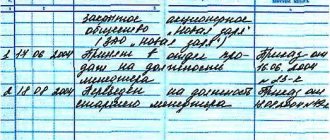Home / Labor Law / Dismissal and layoffs / Dismissal
Back
Published: 04/15/2016
Reading time: 9 min
0
2171
The labor legislation of the Russian Federation provides for two types of employee transfer:
- interior,
- external.
In the first case, it occurs between different departments of the same company; in the second case, the employee is transferred to another organization.
The last type of translation raises the most questions and difficulties. That is why it is worth considering this procedure and the features of its implementation in more detail.
- The essence and features of dismissal with transfer
- Conditions for employee transfer
- Dismissal procedure On the employee’s personal initiative
- With the written consent of the employee
- Upon written request of the new employer
General information
Internal and external transfer to another job
Transfer from work to another can be both internal and external. This depends on the movement of employees within the organization or the release of job vacancies at other enterprises.
More details about translation:
- Internal involves changing jobs in the same organization. The employee has the right to move to another department or change position. This is possible only in agreement with the manager, but the only exceptions are unforeseen circumstances, for example, natural disasters, emergencies and other incidents.
- The concept of external transfer is the complete termination of an employment contract with an employer and the conclusion of an employment agreement with another within a month.
When an employee moves to another place, but if the company remains the same and dismissal is not required.
Types of transfers
Labor legislation provides for the possibility of transferring an employee of two types.
With an internal transfer, the employee is registered in the same organization, but either moves to another unit (for example, department), or begins to engage in another activity with a change in position. It happens that the organization itself changes its actual address. Then the employee’s start of work in another locality is also accompanied by a transfer. Internal transfer is allowed on a temporary or permanent basis.
An external transfer involves a change of employer. In this case, the new position upon transfer can only be permanent.
External transfer is allowed only with the consent of the citizen himself.
For internal transfers, the law in some cases makes exceptions, allowing the employer to make such a decision unilaterally (Article 72.2 of the Labor Code of the Russian Federation). We are talking about emergency cases that require immediate action, for example, accidents, disasters, etc.
Dismissal process through transfer
Concluding an agreement with another employer is the initiative of the employee himself. The following benefits remain:
- guarantee of employment with another representative of the employer;
- compensation for expenses associated with moving to another area of residence in full.
If an employee is transferred at the latter's request, it is necessary to submit a specially designed letter of invitation to another job from the future employer.
The contents of this letter must include the following information:
- full surname and initials of the employee;
- proposed position;
- when the transition will take place;
- certified by the signature of the head with the details of the organization.
With this letter you must attach a letter of resignation stating the reason for the transfer, and it is recommended to indicate the name of the company in full. If the transfer is initiated by the employer himself, then the transfer to another place of work is carried out by agreement of three parties: the employee and two employers.
How to properly accept a transferred employee
The employer needs to remember that Article 70 of the Labor Code prohibits introducing a test when hiring a specialist transferred from another organization.
When filling out an admission order, it is recommended to use the T-1 form. In the column provided for this, you must enter that the reception is carried out as part of the transfer.
The order and the concluded employment agreement must contain the same conditions that were indicated in the invitation to work or other similar document regarding the transfer. It is important to fully comply with the previously specified position, salary, working conditions, etc.
Organization of the translation process
The procedure for transferring to another job through dismissal
After a package of documents has been collected, it must be submitted to the human resources department or the person who is involved in personnel work. The transfer is carried out according to the following scheme:
- An administrative document is prepared based on the employee’s application or a tripartite agreement.
- The document is agreed upon with the interested parties, after which the employee familiarizes himself with it and signs it.
- A dismissal card is filled out, which also requires the employee’s signature.
- It is required to make an entry in the work book with the date and serial number of the administrative document on dismissal.
- The final payment to the employee is made taking into account all due compensation on the final day of work.
- A work book and a certificate of the employee’s salary for the last 2 years worked at the enterprise are issued.
About the advantages of dismissal by transfer
According to Part 2 of Art. 72.1 of the Labor Code of the Russian Federation, at the written request of the employee or with his written consent, the employee can be transferred to a permanent job with another employer. In this case, the employment contract at the previous place of work is terminated in accordance with clause 5, part 1, art. 77 Labor Code of the Russian Federation. Thus, a transfer to another employer implies the mandatory presence of two stages:
1) dismissal of an employee;
2) hiring for another employer.
Both dismissal and hiring of a new job occur in compliance with the norms of the Labor Code of the Russian Federation.
For an employee, the positive side of dismissal by transfer to another employer is that even before dismissal from the original place of work, such an employee has a guarantee of employment with another employer. This guarantee must be enshrined in a letter from the new employer addressed to the original employer or personally to the employee.
There is an opinion that the advantage of dismissal by transfer compared to dismissal at one's own request is that the employee's service in the first case is not interrupted. However, in reality, transferred employees do not have any seniority advantage over employees who were voluntarily dismissed. Let's explain what was said.
Until 2007, the legislation included the concept of “continuous work experience”, the continuity of which influenced the amount of temporary disability benefits (see Rules for calculating the continuous work experience of workers and employees when assigning benefits for state social insurance (approved by the Resolution of the USSR Council of Ministers of April 13, 1973 No. 252)). The work experience was considered continuous if the break in work upon transfer to another employer did not exceed one month, at the same time, for an employee who resigned of his own free will without any valid reasons, the break in work could not exceed three weeks, and in case of repeated dismissal At one's own request, without good reason, the period of service was automatically interrupted during the year. Consequently, in order to maintain continuity of seniority, it was more convenient for employees to resign by transfer.
The concept of “continuous work experience” was replaced by the concept of “insurance period” (the total length of time for paying insurance premiums and/or taxes), enshrined in the Federal Law of July 16, 1999 No. 165-FZ “On the Fundamentals of Compulsory Social Insurance”.
Since the duration of the insurance period is calculated in total, its continuity does not matter for determining the amount of benefits.
Thus, today the opinion that the negative side of voluntary dismissal is a possible interruption of service cannot be considered correct. The insurance period is not interrupted either upon dismissal of one's own free will or upon dismissal by transfer; only its accumulation is suspended.
What compensation is due?
Pay slips are issued on the day of dismissal from the company. These are payments for working time and compensation for unused vacation.
Example of compensation charges. The employee quits on September 30, 2017, but during this year he did not use vacation at all. The duration of the vacation is 28 days. Then the company is required to provide compensation within 14 days.
When transferring to another job, the employee has the following privileges:
- guarantee of employment in another organization within 30 days from the date of dismissal;
- no probationary period is established.
Upon dismissal, all guarantees are lost.
What about vacation?
As mentioned above, dismissed employees are paid compensation for unused vacation days. However, the law does not provide for its preservation during translation. This rule applies in general cases. Thus, an employee will be able to take vacation at a new enterprise only after 6 months of work (Article 122). The transfer can also be carried out while maintaining leave under the following circumstances:
- going on maternity leave;
- the person being dismissed is a minor;
- the dismissed person adopted a child under 3 months old.
How is admission to another organization carried out?
Admission to another organization upon transfer
When an employee starts working in another organization, he must:
- draw up an employment agreement;
- issue an administrative document on employment;
- fill out a personal card;
- make entries in the work book;
- provide instructions;
- obtain permission to work independently in the manner prescribed by regulatory documents.
It is equally important that the future employee undergo a medical examination before applying. Confirmation of health status is important for the employer.
Entry into the labor record: dismissal by transfer
The work book is drawn up in accordance with the requirements of the Labor Code. The entry must contain a reference to Article 84.1. The reason for dismissal, the date of issue and the number of the relevant order must also be stated. The entry must be certified by the signature of the general director of the enterprise or the person responsible for labor documentation. After the book is filled out, the organization's seal is affixed. But when applying for a new position, a note is made about acceptance of the position in connection with the transfer.
Dismissal through transfer for different categories
For some categories of employees, individual solutions are used.
At the legislative level, it is not allowed to transfer young specialists to certain specialties that do not correspond to their profile through dismissal to another job. The transfer of a former student to the specialty in which he received a diploma is only welcome.
However, younger employees themselves should carefully consider their decision, as this will only result in their status being lost. In this case, the state will not be entitled to benefits and compensation payments, and it may be that it will be necessary to return the amounts spent.
But there are also such criteria: when the employee does not pass according to the testimony of the medical commission or the employer does not fulfill basic obligations.
If the employee's probationary period has not expired. During the probationary period, the employee also has the opportunity to transfer. The transfer is carried out as usual.
Nuances
Now let's look at special cases of dismissal during transfer.
If a woman who is on maternity or child care leave is dismissed, the procedure can only be carried out with her consent or on the initiative coming from her.
Labor legislation establishes the impossibility of transferring young specialists to third-party organizations for positions that are in no way related to the specialization received. An employee can lose this status only because of his actions, and this is fraught with the loss of entitlement benefits and compensation. But loss of status does not occur if the employer does not fulfill its obligations, or for medical reasons.
Dismissal through transfer to another employer is a simple and intuitive process. The basis for its registration is the employee’s application. After this, an order is issued and signed by the manager. The employee must be notified of this. After this, the accounting department of the enterprise makes the final calculation: the employee is paid all due compensation for vacation and days worked. If payments are not made on time, the employee has the right to sue the organization. The process is essentially no different from ordinary dismissal. However, employers make a corresponding entry in the work book. For the employer, dismissal does not have any negative consequences. But for the employee this threatens a decrease in earnings and loss of time.
Examples
Examples of transfer through dismissal
In life practice, there are many examples of transfer through dismissal:
- To transfer to another job, all employees must write a letter of resignation. That's what the leader decided. But the new employer did not accept everyone. The workers had nowhere to go but turn to the courts. Based on the decision made, the employer was punished, and the employees were simply required to be hired.
- The employee informed the employer of his intention to move to work in another organization. But the manager refused to sign the statement, citing the fact that his employee is the only qualified specialist who works on this equipment. In this case, the manager is right and does not violate the law.
- If an employee is on maternity leave, then no one has the right to transfer her to another job without her consent. When an employee signs a number of documents and an application drawn up in her own hand, a translation is made in the prescribed manner.
All cases are considered separately, while other circumstances and states of affairs of both the employee and his manager are taken into account.
Dismissal due to transfer, preservation of leave
This is done, as a rule, if the original employer is unable to pay monetary compensation or vacation pay.
Many employees consider this condition convenient, since a transfer to another employer in this case will not affect their unused vacation in any way.
However, by reaching such an agreement to transfer vacation, employers violate labor legislation, namely, the rules on the need to pay monetary compensation for unused vacation or provide vacation with subsequent dismissal (Article 127 of the Labor Code of the Russian Federation).
This norm is imperative and does not allow the settlement of the relations in question by contractual means. If it is not complied with, the employer who did not make a timely payment of monetary compensation and did not provide the employee with leave followed by dismissal, will be held administratively liable in accordance with Art.
In this case, if the employees do not object, then by decision of the employers (current and future), it is possible to transfer employees from one organization to another.
This occurs through dismissal from the previous place of work, since in another organization a new employment contract is concluded with the employee (part 4 of article 64 and part 2 of article 72.1 of the Labor Code of the Russian Federation).
If employees object to this, then they can be dismissed on other grounds, for example, by agreement of the parties (clause
The Labor Code of the Russian Federation is with you. Is vacation preserved during transfer? Is vacation preserved during transfer?. more 0 answers. Required field. Saving... Spell check Yandex.Speller. Unused vacation, and the company is liquidated.
This is all specified in the contract; each organization sets its own rules and by signing them you must obey them. For example: if the contract says that employees will work for 3-4 years without vacations and you signed it, then even the court cannot do anything.
In the case of transfer of an employee working under a contract, with his consent, to another job or unit, but within the limits of his specialty, qualification or position while maintaining working conditions, what to do with unused vacation upon his dismissal? We had such a situation.
New employment contracts from April 1.
List of messages IP/Host: 84.42.28. leave upon transfer - URGENT :sos: Transfer of an employee to another employer in accordance with Art. 72 of the Labor Code of the Russian Federation provides for the preservation of vacation for him?, or compensation is paid for non-vacation.
URGENT #1 IP/Host: 87.249.7. Registration date: 08/19/2011 Messages: 12,379 Re: leave during transfer - URGENT :sos: Anonymous user Writes: Transfer of an employee to another employer in accordance with Art.
This occurs through dismissal from the previous place of work, since in another organization a new employment contract is concluded with the employee (part 4 of article 64 and part 2 of article 72.1 of the Labor Code of the Russian Federation). If employees object to this, then they can be dismissed on other grounds, for example, by agreement of the parties (clause
How to transfer staff from one company to another We thank our reader, Tatyana Aleksandrovna Skripova, chief accountant of Superfruit LLC, Syktyvkar, Komi Republic, for the suggested topic of the article. Sometimes the owners of an organization divide the business, and with it the employees.
In this case, some of the workers can be transferred en masse either to an already existing or to a newly created company. With such a transfer, nothing may change for employees.
In this case, the day of dismissal is also considered the last day of vacation. When granting leave with subsequent dismissal upon termination of the employment contract at the initiative of the employee, this employee has the right to withdraw his resignation letter before the start date of the vacation, unless another employee is invited to take his place by way of transfer.
Moreover, I will cite articles from the rules on regular paid and additional leaves28. When dismissing an employee who has not used his right to vacation, he is paid compensation for unused vacation.
These are the exact norms of labor legislation, verbatim. You can draw your own conclusions. The black line can take off #8 IP/Host: 84.42.28.
The saved work experience is the time of actual work when calculating the length of service giving the right to annual leave, in accordance with Article 121 of the Labor Code of the Russian Federation. In this case, the right to the next annual leave for an employee transferred to another employer is ensured by: months worked at the previous job, plus months worked at the job to which he was transferred.
Therefore, if there were any changes in the Labor Code regarding non-saving of vacation when transferring to another employer, maybe.
Leave when transferring within the company
As I understand it, when an employee is dismissed by transfer to another organization, the employee’s vacation days are not retained at the new place of work? No continuous experience? You still need to manage to live to 60, not in the number of days, but in the amount of your salary!
Two of my peers (40), one retired after 20 years in the north as a submariner and due to disability, worked only 5 years in a criminal position, receive the same pension amount! If you live to the deadline, they will pay you!
We thank our reader, Tatyana Aleksandrovna Skripova, chief accountant of Superfruit LLC, Syktyvkar, Komi Republic, for suggesting the topic of the article
Sometimes the owners of an organization divide the business, and along with it the employees. In this case, some of the workers can be transferred en masse either to an already existing or to a newly created company. With such a transfer, nothing may change for employees.
There are often cases when employees get promoted or change the department in which they work. All these situations are internal transfers, i.e. movements within one company (legal entity).
Consequently, such an employee retains most of the previous constants, such as a personnel number, an employment contract, the right to rest and the number of days off. Since the employee is not fired, he remains included in the vacation schedule and can go on it as planned. Unless a situation arises where the employer has the right to postpone vacation dates.
When transferring, leave is retained if such transfer was made within the same enterprise. In the process of formalizing the transfer of an employee from position to position, an additional agreement to the employment contract is drawn up. The text of the agreement must specify all changing terms of the contract:
- new position, division;
- new salary (tariff rate);
- new rules for calculating vacation, etc.
According to the labor code, all workers can count on 28 calendar days of vacation. Therefore, it is impossible to reduce its duration during translation. In addition, if the employee is given an irregular schedule or new working conditions are harmful to his health, he is entitled to additional leave.
We suggest you read: How to pay a nurse if the doctor is on vacation
The amount of additional rest, as a rule, is prescribed in the collective agreement or other company regulations. It would not be superfluous to indicate the additional size. vacation in an additional agreement to the employment contract.
Note! The calculation of length of service for the next vacation for a transferred employee will not change and will be counted from the date of admission. Whereas he has the right to an additional one only after moving. And, accordingly, the countdown of the calendar year will begin from the date of transfer.











